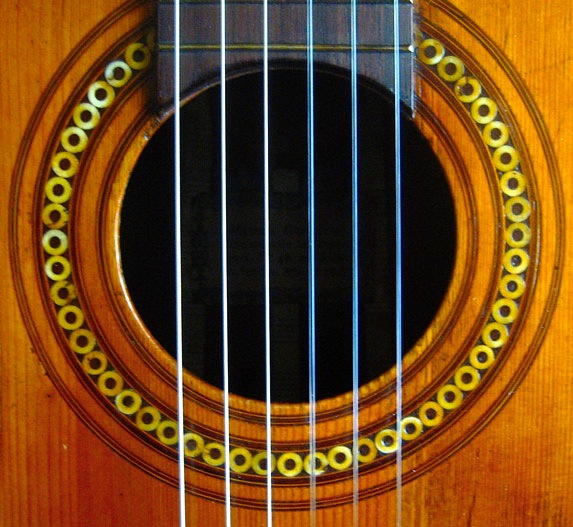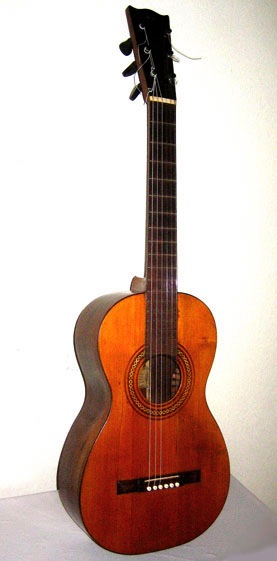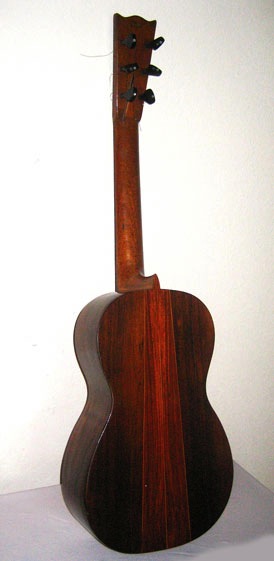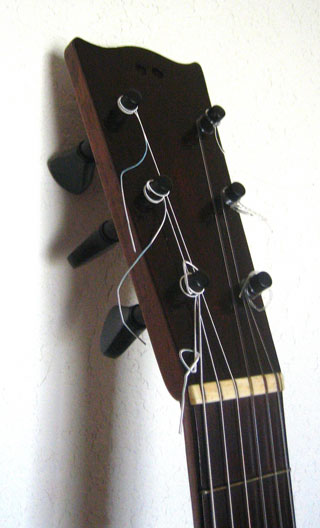Manuel Gutiérrez Martínez was born in Sevilla in 1773. As his father was a silversmith, it is uncertain where Manuel learned his trade. Over the course of his long carrier in Sevilla Manuel had a number of workshops. In 1836 he had a workshop at Calle Cerrageria 46. In 1844, his workshop was at Calle Cerrageria 44. In 1845-46, it was at Calle Cerrageria 35. In 1847-48, he was at Ballestilla 10. In 1849, he moved to Cerrageria 36, a few doors away from no. 32, where Antonio de Torres worked from 1856-1868. Manuel shared this shop with María Dolores Gómez Sánchez (b. 1805-d.1867), his apprentice and disciple who had joined his shop in the 1840s. Manuel never married, so when he died of asthma on the 25th of May, 1857, Maria Gomez, inherited this shop from her master, and continued to list Manuel's name in the trade guides until she retired in 1868, and sold the shop to Manuel Soto y Solares (b1839-d.1906).

Manuel Gutierrez chief claim to fame is that he was a close friend of Antonio Torres (b. 1817- d. 1892). According to Prat (1934:374) for a time when Torres was first becoming established in Sevilla, Gutierrez shared his workshop at calle Cerrageria 36 with him. Torres arrived in Sevilla in 1845. During this period, Torres was not a full time builder, but was being encouraged by Julian Arcas, a Spanish guitarist and virtuoso. (Romanillos and Winspear 2002:176). Torres probably shared Manuel's workshop sometime between 1849 and 1854, when Torres opened his own workshop at Ballestilia 11, moving then to Cerrageria 32.
Although Jose Pernas (b.c. 1802 - d after 1866) is credited by some by some as Torres teacher, Romanillos believes it is doubtful that this Granada maker was his teacher. Romanillos notes that Torres guitars have much more affinity with guitars made in Cadiz and Sevilla than with those of Pernas. Romanillos, suggests that (FE 2) shows that Torres was still learning his art in 1854. An interesting question is whether Gutierrez may have taught Torres something of the luthier's art. It is hard to assess just how much Torres learned from contact with other makers in Sevilla, "in particular with Manuel Gutierrez, it is probable that he was able to learn certain techniques to help him in his career" (Ramanillos 1995:20-21).
Frank Wallace, a concert guitarist who has record with a 1854 Gutiérrez (Gyremusic CD), and has had a chance to compare it with the 1857 Torres (FE 07) in the Yale University Musical Instruments Collection, believes the elderly Gutiérrez must have shared his knowledge with Torres. Romanillos makes an interesting observation on the 1857 Torres (FE 07) in the Yale collection. He notes that Torres seems to have used an old neck that was originally made for a double course guitar, given that this guitar has a bull's horn headstock like Gutierrez used, it is possible that he got this neck from him. There are other indisputable similarities between these instruments. They are alike in size, shape and lightness of construction," with the exception that Gutiérrez' has a deeper body (over 100 mm!). "Both instruments have three-piece backs, five radial struts, a v-shaped shaft splice, and an almost identical headstock, in a shape reminiscent of bull's horns." Wallace also observes, "similar techniques were clearly used by Gutiérrez to refine the top of our guitar, whose thickness varies widely from 1.4-2.2 mm. Their sound is remarkably similar, in spite of the different woods for the back and sides (Gutiérrez, Brazilian rosewood; Torres, cypress). Both are rich, dark, full and complex in sound.”
The back and sides of the 1837 Gutierrez are made of brazilian rosewood. The back is assemble for 5 pieces into three contrasting sections. The top is made of German spruce. The top is braced with five fan braces with the outer braces on each side abutting and coming off its neighbor at a steeper angle. The bridge seems to be a later replacement. This guitar originally probably had a tie bridge with no nut or pins. Like the 1854, this 1837 Manuel Gutierrez has a deep body measuring 100 mm at the neck, and 108 mm at the end. Its string scale is 645 mm, and the fingerboard is 52 mm at the nut. While it has had a number repaired cracks, over all it is in very good condition. Acoustically, although this guitar is small, its tall sides gives its body a column of air comparable to a larger instrument. This heard in the depth of its tone. It is very responsive, and has excellent volume and power. The basses are woody, dark, rich, defined, and complex. The mid-range is well-developed producing lush notes. The trebles sing. They are sweet, rounded, polished, clear, incisive, and have great depth.
Prat, Domingo. (1986).Diccionario de Guitarras. Columbus, Ohio: Ediciones Orphée Inc. [Originally published in 1934].
Romanillos, José L. and Marian Harris Winspear, (1995). Antonio de Torres, Guitar Maker - His Life and Work. West Port, CT: The Bold Strummer, Ltd.
Romanillos Vega, José L. and Marian Harris Winspear, (2002). (The Vihuela and the Spanish Guitar. A Dictionary of the Makers of Plucked and Bowed Musical Instruments of Spain (1200-2002). Guijosa, Spain: The Saguino Press.




